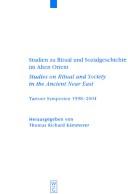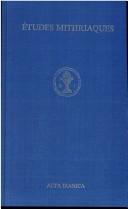| Listing 1 - 3 of 3 |
Sort by
|

ISBN: 9783110194616 3110194619 Year: 2007 Volume: 374 Publisher: Berlin: de Gruyter,
Abstract | Keywords | Export | Availability | Bookmark
 Loading...
Loading...Choose an application
- Reference Manager
- EndNote
- RefWorks (Direct export to RefWorks)
This volume contains the revised versions of lectures that were delivered by scholars from Germany, England, USA, Finland and, more recently, Russia to the first five international symposia on ancient oriental languages and cultures held between 1998 and 2004 at the Faculty of Theology of the University of Tartu, Estonia. Particular emphasis is placed on the analysis of specific problems of the history of religion and medicine, of linguistics and of the archaeology of the Eastern Mediterranean.
Semites --- Civilization, Semitic --- Religion --- Middle East --- Social conditions --- 229*2 --- Apocriefen van het Oude Testament. Pseudepigrafen van het Oude Testament --- 229*2 Apocriefen van het Oude Testament. Pseudepigrafen van het Oude Testament --- Caucasian race --- Semitic civilization --- Asia, South West --- Asia, Southwest --- Asia, West --- Asia, Western --- East (Middle East) --- Eastern Mediterranean --- Fertile Crescent --- Levant --- Mediterranean Region, Eastern --- Mideast --- Near East --- Northern Tier (Middle East) --- South West Asia --- Southwest Asia --- West Asia --- Western Asia --- Orient
Book
ISBN: 9780521194044 Year: 2011 Publisher: Cambridge [etc.] Cambridge University Press
Abstract | Keywords | Export | Availability | Bookmark
 Loading...
Loading...Choose an application
- Reference Manager
- EndNote
- RefWorks (Direct export to RefWorks)
"The Barbarians of Ancient Europe deals with the reality of the indigenous peoples of Europe, in contrast to many publications that explore these peoples in the context of the Greek idea of 'barbarians' as the 'Other'. These varied groups--Thracians, Scythians, Celts, Germans, Etruscans, and other peoples of Italy, the Alps, and beyond--had contact with one another and with Greek culture during its flowering. Images on the spectacular gold and silver objects buried in royal tombs show how the horse-riding nomads and the barbarian women warriors known in antiquity as Amazons saw themselves. Archaeological discoveries show how they dressed, what they ate and drank, where they lived, and how they honored their dead kings with barbaric splendor and human sacrifices, allowing us to change, correct, or confirm the picture given in Greek and Roman literature"--
Indo-Europeans --- Acculturation --- Social change --- Ethnohistory --- Ethnoarchaeology --- Indo-Européens --- Changement social --- Ethnohistoire --- Ethnoarchéologie --- History --- Cultural assimilation --- Antiquities --- Histoire --- Antiquités --- Europe --- Civilization --- Greek influences --- Civilisation --- Influence grecque --- Indo-Européens --- Ethnoarchéologie --- Antiquités --- History. --- Change, Social --- Cultural change --- Cultural transformation --- Societal change --- Socio-cultural change --- Social history --- Social evolution --- Aryans --- Civilization, Aryan --- Civilization, Indo-European --- Indo-Germanic peoples --- Caucasian race --- Ethnology --- Ethnohistorical method --- Historical anthropology --- Historical ethnology --- Anthropology --- Ethnic archaeology --- Ethnicity in archaeology --- Ethnology in archaeology --- Archaeology --- Social archaeology --- Culture contact --- Development education --- Culture --- Assimilation (Sociology) --- Cultural fusion --- Methodology --- Council of Europe countries --- Eastern Hemisphere --- Eurasia --- Culture contact (Acculturation)

ISBN: 9004056890 9004039023 9004043284 9004043985 9004045384 9004048170 9004048189 9004043292 9004043934 9004039007 9004039015 9004041966 9004043942 9004043993 9004056068 9004045392 9004045406 9004056297 9004057617 9789004043992 9789004039025 9789004043947 9789004045385 9789004045392 9789004048188 9789004048171 9789004056893 9789004057616 9789004056060 9789004056299 9789004045408 9789004041967 9789004039001 9789004039018 9004671390 9004671358 9004672036 9004671048 9004671382 9004670971 9004672028 900467098X 9004671404 900467134X 9004671412 9004672079 9004671366 9789004671362 9789004672079 9789004671416 9789004671409 9789004671355 9789004671393 9789004671386 9789004671041 9789004671348 9789004672031 Year: 1977 Volume: 4-7 1-4 Publisher: Téhéran: Bibliothèque Pahlavi,
Abstract | Keywords | Export | Availability | Bookmark
 Loading...
Loading...Choose an application
- Reference Manager
- EndNote
- RefWorks (Direct export to RefWorks)
Scholarly studies of topics in the art, archaeology, ancient history and linguistics of the Iranian region.
Mithraism --- Congresses --- Art, Archaemenid. --- Buddhism --- Buddhist literature, Sogdian --- Inscriptions, Pahlavi. --- Iranian philology. --- Kings and rulers in art. --- Manichaeism --- Manichaeism. --- Pahlavi language --- Parthian language --- Sufis --- Sacred books. --- History and criticism. --- Early works to 1800. --- Congresses. --- Etymology. --- Glossaries, vocabularies, etc. --- Orthography and spelling. --- Phonology. --- Readers --- Biography. --- Manichéisme --- Zoroastrianism --- Zoroastrisme --- Zoroaster --- Avesta --- Iranian philology --- Philologie iranienne --- Early works to 1800 --- Ouvrages avant 1800 --- Glossaries, vocabularies, etc --- Reader in Manichaean Middle Persian, and Parthian --- Soufis --- Biography --- Biographies --- Iran --- Religion --- Antiquities --- Civilization --- Antiquités --- Civilisation --- Inscriptions, Pahlavi --- Inscriptions pahlavi --- Orthography and spelling --- Phonology --- Bouddhisme --- Sacred books --- History and criticism --- Livres sacrés --- Indo-European languages --- Indo-Iranian philology --- Langues indo-européennes --- Philologie indo-iranienne --- Etymology --- Etymologie --- Indo-European philology --- Indo-Europeans --- 491 --- Aryan philology --- Aryans --- Civilization, Aryan --- Civilization, Indo-European --- Indo-Germanic peoples --- Caucasian race --- Ethnology --- Aryan languages --- Indo-Germanic languages --- Kinship --- Languages Other languages Indo-European --- 491.53 --- Iranian languages, Middle --- Huzvaresh --- Middle Persian language --- Parsi language --- Pazend --- Pehlevi language --- Persian language --- Extinct languages --- Languages Middle Iranian languages --- Middle Persian --- Pahlavi --- Reader in Manichaean Middle Persian, and Parthian. --- 955 --- History Iran --- Antiquities. --- Civilization. --- -Sufis --- -Pahlavi language --- -Parthian language --- -Manichaeism --- -Buddhist literature, Sogdian --- -Buddhism --- -Zoroastrianism --- Art, Archaemenid --- Kings and rulers in art --- 291.0955 --- Kings in art --- Mazdaism --- Mazdeism --- Religions --- Dualism (Religion) --- Philosophy, Ancient --- Eranian philology --- Indo-Aryan philology --- Buddha and Buddhism --- Lamaism --- Ris-med (Lamaism) --- Sogdian Buddhist literature --- Sogdian literature --- Sufism --- Religion Comparative religion Iran --- Christianity --- Zartusht --- Zarathustra --- Zarādusht --- Zarathoustra --- Zoroastre --- Zerdüşt --- Zarathushtra --- Zurtasht --- زرادشت --- زرتشت --- 295 --- 295.4 --- 295.4 Zoroastrisme. Mazdaisme. Zend-Avesta. Zarathoestra --- Zoroastrisme. Mazdaisme. Zend-Avesta. Zarathoestra --- Religion Zoroastrianism --- Zoroaster. --- Readers&delete& --- Iran. --- 297.4092 --- Religion Islam Ethics and religious experience, life, practice Persons --- 299.15 --- 295.2 --- 295.2 Mithras-cultus --- Mithras-cultus --- Mithras (Zoroastrian deity) --- Religion Mithraism --- Cyrus, --- 491.5 --- Languages Iranian --- 294.3 --- 091 <41 LONDON> --- 091 =915 --- 091 =915 Handschriftenkunde. Handschriftencatalogi--Iraans. Perzisch --- Handschriftenkunde. Handschriftencatalogi--Iraans. Perzisch --- 091 <41 LONDON> Handschriftenkunde. Handschriftencatalogi--Verenigd Koninkrijk van Groot-Brittannië en Noord-Ierland--LONDON --- Handschriftenkunde. Handschriftencatalogi--Verenigd Koninkrijk van Groot-Brittannië en Noord-Ierland--LONDON --- Buddhist literature --- Religion Buddhism --- Avesta. --- República Islâmica do Irã --- Irã --- Persia --- Northern Tier --- Islamic Republic of Iran --- Jumhūrī-i Islāmī-i Īrān --- I-lang --- Paras-Iran --- Paras --- Persia-Iran --- I.R.A. --- Islamische Republik Iran --- Islamskai︠a︡ Respublika Iran --- I.R.I. --- IRI --- ايران --- جمهورى اسلامى ايران --- Êran --- Komarî Îslamî Êran --- Pahlavi language - Readers - Manichaeism --- Parthian language - Readers - Manichaeism --- Buddhist literature, Sogdian - History and criticism --- Buddhism - Sacred books --- Manichaeism - Early works to 1800 --- Mithraism - Congresses --- Pahlavi language - Phonology --- Pahlavi language - Etymology --- Pahlavi language - Orthography and spelling --- Avesta. Yasna. Gatha --- Critique, interprétation, etc. --- Sources --- Abū Saʿīd Faḍl Allāh ibn Abī al-H̱ayr (0967-1050?) --- Mystique --- Islam --- Parthe (langue) --- Langues iraniennes moyennes --- Textes --- Persan (langue) --- Jusqu'à 651 --- Jusqu'à 651 --- Langues indo-iraniennes --- Pehlevi (langue) --- Mithra (divinité zoroastrienne) --- Inscriptions sassanides --- Sogdien (langue) --- Asie centrale --- Histoire --- Cyrus, - King of Persia, - d. 529 B.C. --- Mani, active 3rd century. --- Manichaeism Hymns. --- Parthian language. --- Texts. --- Indo-European philology. --- Kinship. --- Buddhist literature, Sogdian. --- Manuscripts, Sogdian.
| Listing 1 - 3 of 3 |
Sort by
|

 Search
Search Feedback
Feedback About UniCat
About UniCat  Help
Help News
News